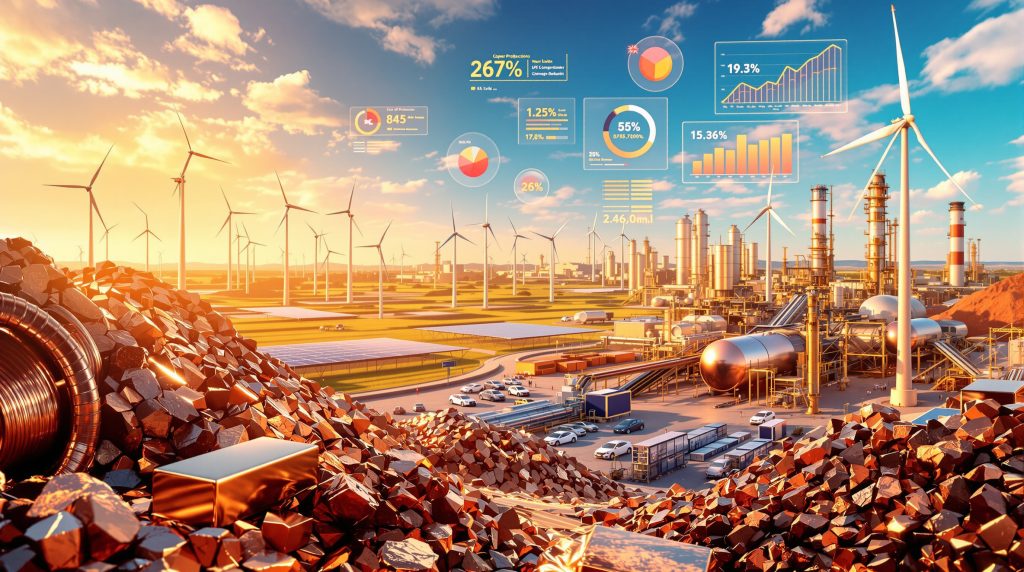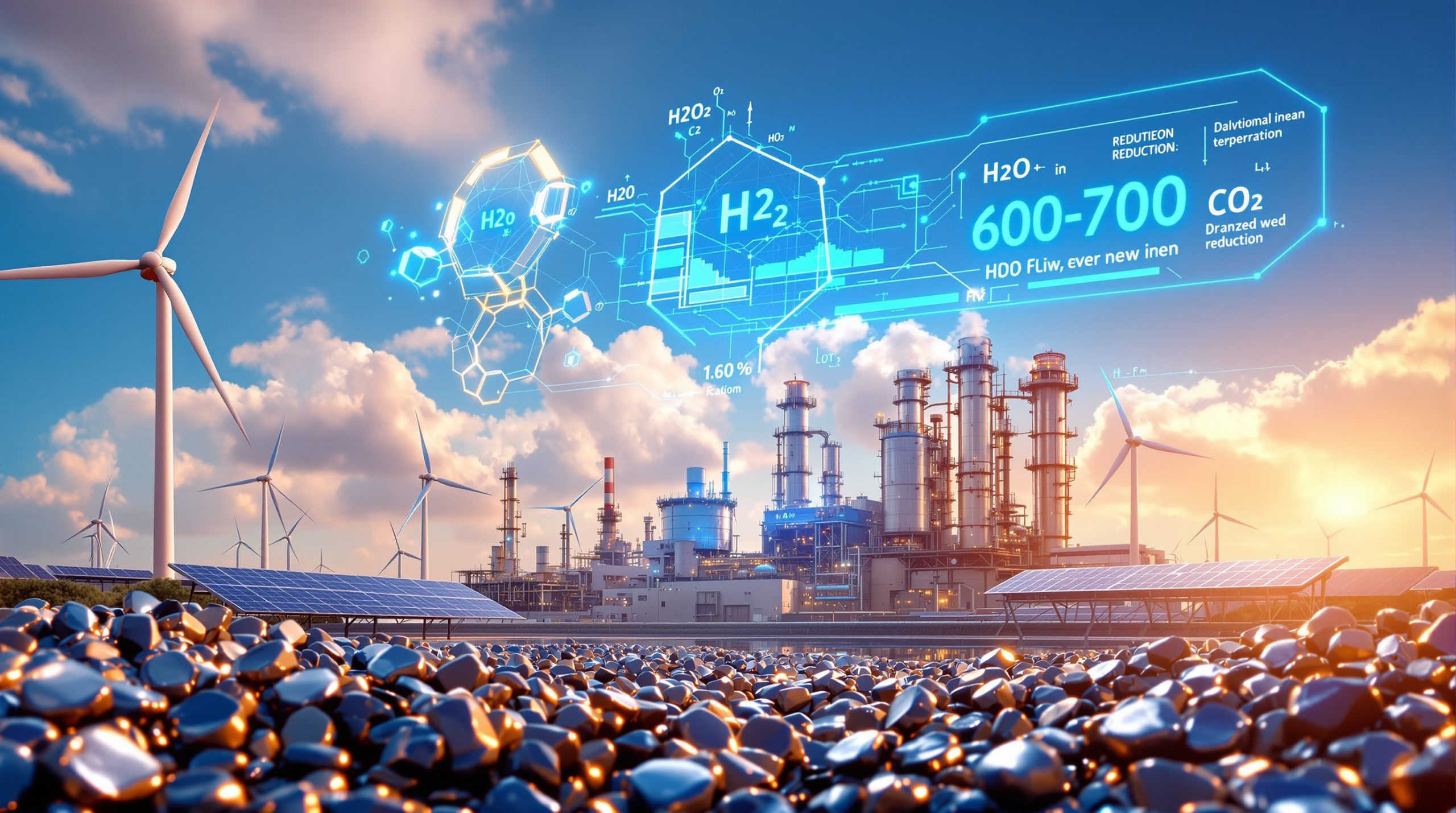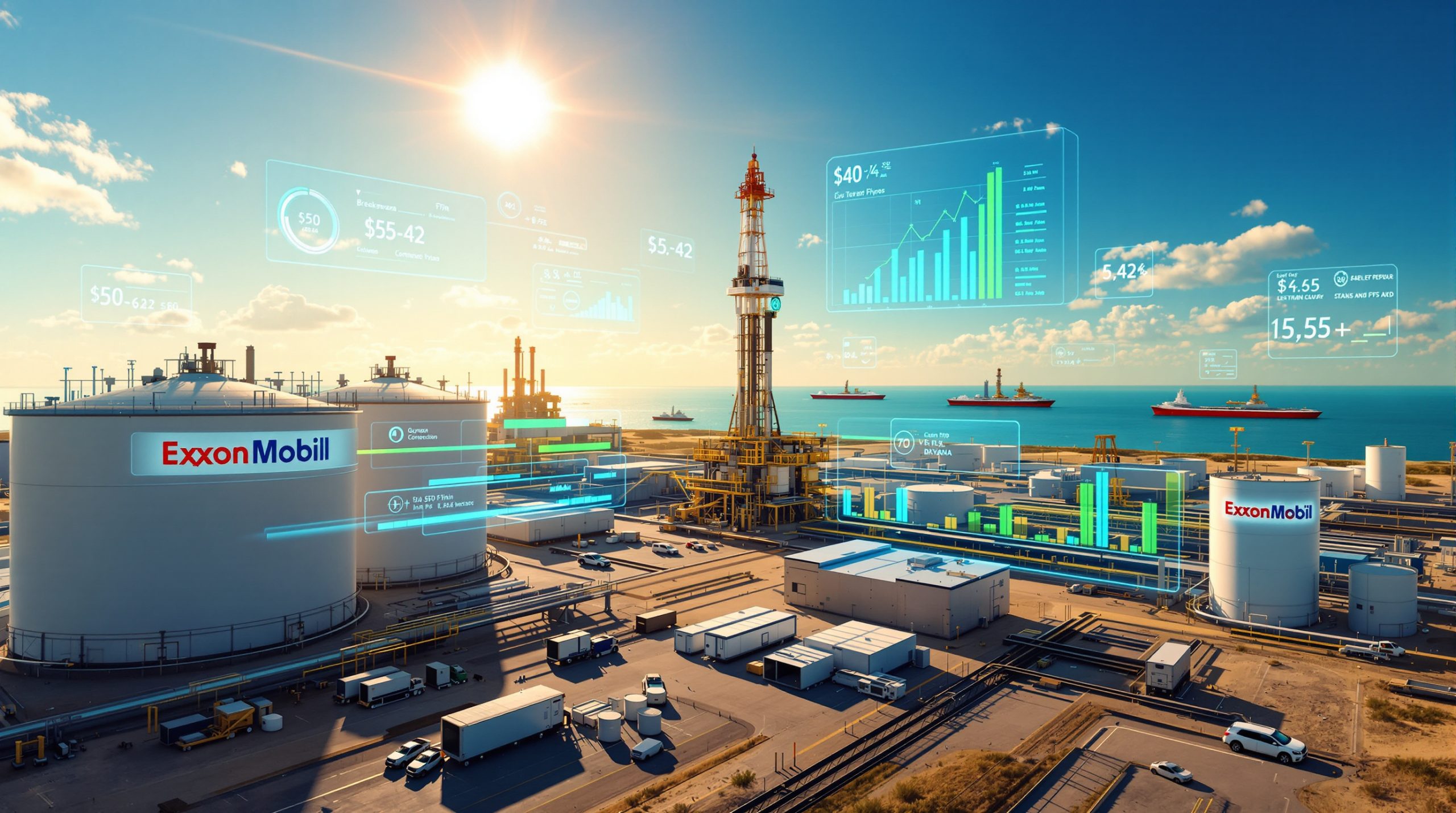The Science Behind Copper's Clean Energy Advantage
The atomic structure of copper positions it as nature's optimal conductor for large-scale electrical applications. With its single valence electron configuration, copper delivers superior electron mobility compared to alternative materials, making copper set to rewire net zero goals fundamentally essential for renewable energy infrastructure.
Clean energy technologies demand approximately five times more copper than conventional systems, according to research from CSIRO's strategic copper initiatives. This dramatic increase stems from copper's exceptional electrical and thermal conductivity properties, which become critical when minimizing energy losses across renewable power grids.
Wind turbines exemplify this copper intensity, requiring up to 5 tonnes of copper per megawatt of generating capacity. Electric vehicles contain approximately 60-90 kg of copper per vehicle, representing four times the copper content of traditional internal combustion engine cars. These applications rely on copper's ability to efficiently transfer electrical energy with minimal resistance losses.
Conductivity Properties That Enable Clean Energy
Copper's electrical conductivity measures 59.6 × 10⁶ Siemens per meter at room temperature, second only to silver in performance. However, when factoring installation costs and required conductor cross-sectional areas, copper typically costs 15-25% less than aluminum alternatives for large-scale transmission projects.
The metal's thermal conductivity of 385-401 W/m·K enables efficient heat dissipation in high-power applications, preventing equipment failures that could compromise grid reliability. This thermal management capability becomes increasingly important as renewable energy systems operate at higher power densities.
Transmission line losses can be reduced by 2-3% through optimized copper conductor sizing, a significant improvement when scaled across national electricity grids. These efficiency gains directly translate to reduced carbon emissions and improved economic returns for renewable energy investments.
Breaking Down Future Copper Demand by Sector
Global copper consumption currently measures approximately 25 million tonnes annually, but achieving net zero emissions by 2050 will require doubling this demand to nearly 50 million tonnes per year. Furthermore, the rising copper demand from clean energy applications will account for over 80% of copper demand growth through 2050.
| Application | Current Usage (%) | 2050 Projected Usage (%) | Growth Factor |
|---|---|---|---|
| Power grids & transmission | 15% | 28% | 3.7x |
| Electric vehicles | 3% | 18% | 12x |
| Renewable generation | 8% | 22% | 5.5x |
| Building electrification | 12% | 16% | 2.7x |
| Traditional applications | 62% | 16% | 0.5x |
The most dramatic growth will occur in electric vehicle applications, where copper demand could increase twelve-fold as transportation electrification accelerates. Each electric vehicle requires copper for wiring harnesses, motors, transformers, and battery management systems, with content varying from 60-90 kg depending on vehicle size and battery capacity.
Power grid modernization and transmission expansion will drive 3.7 times current copper usage in grid applications. Smart grid technologies require increased copper for sensor networks and communications infrastructure, while battery energy storage systems demand significant copper for power electronics and grid interconnection equipment.
Renewable Energy Infrastructure Copper Requirements
Utility-scale solar installations require copper in mounting systems, inverters, and transmission infrastructure. Distributed solar systems, such as rooftop installations, need approximately 40-60 kg of copper per 10 kW installation for wiring, inverters, and grid connection equipment.
Wind energy projects utilize copper in generator windings, transformer systems, and electrical collection networks. Offshore wind installations require additional copper for submarine cables and grid interconnection infrastructure, with projects often requiring 6-8 tonnes of copper per megawatt due to longer transmission distances.
While recycled copper can preferentially serve traditional applications, the rapid deployment of new EV and renewable generation infrastructure creates capital stock with 20-30 year lifespans that cannot be met by current recycling volumes until 2045-2050 when early installations reach end-of-life.
The Looming Supply-Demand Gap
Mining industry analysis reveals a potential copper shortfall of nearly 10 million tonnes by 2035, representing approximately a 20% gap between projected demand and current supply capacity. This shortage timeline coincides with the critical decade for climate action, creating potential bottlenecks for renewable energy deployment.
Critical supply constraints threatening net zero goals:
-
Mine development timelines: New copper projects typically require 15-20 years from discovery to production
-
Declining ore grades: Average copper ore grades have fallen from 1.6% in 1900 to 0.6% today
-
Geographic concentration: Over 40% of global copper reserves are located in Chile and Peru
-
Infrastructure limitations: Many deposits lack access to power, water, and transportation networks
Processing Challenges from Declining Ore Quality
The decline in ore grades means mining operations must process 3.3 times more ore to obtain the same copper volume compared to historical operations. This dramatically increases energy consumption by 150-200%, water usage by 250-350%, and operating costs by 35-45%.
Chile's Escondida mine, producing 5% of global copper supply, exemplifies both the scale and challenges facing the industry. Located in the Atacama Desert, the operation consumes 65% of regional freshwater resources while processing increasingly low-grade ore deposits.
Many African Copperbelt deposits in the Democratic Republic of Congo and Zambia lack stable electricity infrastructure, limiting production expansion despite significant ore reserves. Remote deposits like Mongolia's Oyu Tolgoi require substantial transport infrastructure investment before reaching full production capacity.
Regional Supply Security Concerns
Countries heavily dependent on copper imports face potential bottlenecks in their energy transition timelines if supply chain disruptions occur during peak demand periods.
China imports approximately 40% of its copper consumption, creating vulnerability to supply chain disruptions. The European Union imports over 80% of copper requirements, while in contrast, US copper production helps the United States import roughly 40% of consumption despite operating significant domestic mines.
Political instability in Peru has led to temporary production halts affecting approximately 15% of global copper supply, with spot prices increasing 8-12% during disruption periods. Such volatility demonstrates the fragility of supply chains supporting global decarbonization efforts.
Can Recycling Bridge the Copper Supply Gap?
Copper recycling currently provides approximately 35% of global supply, with the metal maintaining its properties through unlimited recycling cycles. The Commonwealth Scientific and Industrial Research Organisation notes that nearly one-third of global copper demand is met through recycling, making it central to sustainability and circular economy objectives.
Recycling Advantages and Energy Savings
Secondary copper production requires 85% less energy than primary copper production from mining operations. This energy efficiency stems from bypassing energy-intensive mining, milling, and concentration processes required for ore processing.
Key recycling benefits:
-
Full electrical and thermal conductivity maintained through unlimited recycling
-
No material degradation with repeated recycling cycles
-
Reduced mining pressure on new deposit development
-
More predictable supply chains independent of geological constraints
Scaling Constraints and Timeline Challenges
Available scrap copper is limited by existing infrastructure age, with buildings typically having 50-100 year lifespans and appliances lasting 10-15 years. Consequently, the urban mining potential from electronics achieves recovery rates of 85-95%, but requires substantial infrastructure investment.
Critical recycling limitations:
-
Contaminated scrap requires additional processing, increasing costs by 15-30%
-
Quality variations in recycled copper affect specific high-performance applications
-
Collection and processing infrastructure requires significant capital investment
-
Purity levels from secondary material typically reach 99.5-99.9% versus 99.99%+ from primary production
Advanced recycling technologies could potentially meet 40% of new copper demand by 2030, but the lag between infrastructure investment and production ramp-up creates timing problems. Recycling infrastructure deployed in 2025-2027 will not reach full capacity until 2030-2035, precisely when peak copper demand growth occurs.
How Is the Mining Industry Decarbonizing Copper Production?
The copper mining sector faces a dual challenge: dramatically increasing production while reducing its own carbon footprint. Current copper production generates approximately 4 tonnes of CO2 equivalent per tonne of refined copper, creating pressure for emissions reduction alongside supply expansion.
Emissions Reduction Roadmaps
Mining companies are implementing comprehensive decarbonization strategies to address both production scaling and sustainability objectives:
-
Renewable energy integration: Converting mine operations to solar and wind power systems
-
Process electrification: Replacing diesel equipment with electric alternatives for mobile mining equipment
-
Hydrogen applications: Using green hydrogen for high-temperature smelting and refining processes
-
Digital optimization: AI-driven efficiency improvements reducing energy consumption across operations
-
Carbon capture technologies: Capturing emissions from smelting operations and processing facilities
Technology Innovation in Sustainable Mining
Breakthrough technologies are emerging to address both supply and sustainability challenges facing the copper industry. Furthermore, the mining decarbonisation benefits become increasingly clear as these technologies develop:
Next-generation extraction methods:
-
In-situ leaching: Extracting copper without traditional mining methods, reducing surface disturbance
-
Bioleaching: Using microorganisms to process low-grade ores with reduced energy requirements
-
Deep sea mining: Accessing polymetallic nodules containing copper from ocean floors
-
Urban mining: Recovering copper from electronic waste streams and demolished infrastructure
These technologies offer potential pathways to increase copper supply while reducing environmental impact, though most remain in development or early commercial deployment phases.
Which Countries Are Best Positioned for Copper-Driven Energy Transition?
Global Copper Resource Distribution
Chile holds approximately 28-30% of world's identified copper reserves, while Peru controls 10-13%, combining for over 40% of global reserves. This geographic concentration creates both opportunities and risks for global supply security.
Australia possesses significant copper reserves distributed across multiple states, reducing geographic concentration risks compared to other major producers. The country offers several strategic advantages:
Australia's competitive positioning:
-
Stable political environment attracting long-term mining investment
-
Advanced mining technology and operational expertise
-
Established infrastructure in key mining regions
-
Strong environmental and safety regulatory frameworks
-
Proximity to major Asian copper consuming markets
Emerging Copper Provinces
Several regions are developing as new copper supply sources to diversify global production:
Democratic Republic of Congo: Currently the largest cobalt producer with significant copper co-production potential, though political instability limits investment
Mongolia: Oyu Tolgoi represents one of the world's largest undeveloped copper deposits, requiring substantial infrastructure development
Zambia: Expanding production capacity in the African Copperbelt region with improved mining technologies
Canada: Developing Arctic deposits with potentially lower environmental impact through advanced mining methods
These emerging regions could provide additional supply diversity, reducing dependence on traditional South American producers while supporting global decarbonization objectives.
What Role Do Major Mining Companies Play in Net Zero Copper Supply?
Strategic Production Expansion
Leading mining companies are restructuring portfolios to prioritize copper production for energy transition applications. This strategic shift involves divesting from thermal coal assets while investing heavily in copper capacity expansion across existing and new operations.
Investment priorities for major producers:
-
Expanding existing high-grade copper operations to maximize output from proven reserves
-
Developing new tier-one copper deposits with multi-decade production profiles
-
Implementing sustainable mining practices to meet environmental standards
-
Building resilient supply chain partnerships with clean energy developers
Major copper producers recognize that energy transition demand represents a fundamental shift in market dynamics, requiring long-term strategic planning rather than cyclical production adjustments.
Technology Partnerships and Innovation
Mining companies are forming strategic partnerships with technology firms to develop next-generation mining solutions delivering both increased production and reduced environmental impact. These collaborations focus on automation, electrification, and process optimization.
Key innovation areas:
-
Autonomous mining equipment reducing operational costs and safety risks
-
Advanced ore sorting technologies improving processing efficiency
-
Real-time monitoring systems optimizing energy consumption
-
Predictive maintenance reducing equipment downtime and resource waste
These technological advances aim to offset declining ore grades while improving operational sustainability, essential for meeting both production targets and environmental commitments.
How Will Copper Pricing Impact Energy Transition Timelines?
Price Volatility and Investment Decisions
Copper price fluctuations directly influence both mining investment decisions and clean energy project economics. For instance, copper price insights suggest sustained higher prices incentivize new mine development but can slow renewable energy deployment by increasing infrastructure costs.
Price impact factors affecting markets:
-
Supply constraint recognition driving premium pricing for long-term contracts
-
Speculative trading based on energy transition demand projections
-
Currency fluctuations affecting international trade and investment returns
-
Geopolitical tensions impacting supply chain security and risk premiums
Recent political unrest in Peru affecting 15% of global copper supply demonstrated how quickly supply disruptions can drive price volatility, with spot prices increasing 8-12% during temporary production halts.
Long-term Price Projections
Industry analysts project copper prices will remain elevated through 2030 as supply struggles to match energy transition demand, potentially creating feedback effects on clean energy adoption rates. According to global decarbonisation research, potential copper deficits of 3-4 million tonnes by 2030 support sustained higher pricing.
Higher copper prices create mixed impacts on decarbonization efforts. While increased prices incentivize mining investment and production expansion, they also raise costs for renewable energy infrastructure, potentially slowing deployment in price-sensitive markets.
Strategic buyers in the renewable energy sector are increasingly entering long-term supply agreements to secure copper availability and manage price volatility, indicating industry recognition of supply constraints ahead.
What Policy Interventions Could Accelerate Copper Supply?
Government Support Mechanisms
Strategic policy frameworks can address both supply security and sustainability objectives while accelerating copper production for energy transition applications:
Recommended policy interventions:
-
Fast-track permitting processes for strategic mineral projects meeting sustainability criteria
-
Tax incentives for sustainable mining practices and renewable energy adoption in operations
-
Research funding for copper recycling technologies and urban mining development
-
International cooperation agreements on critical mineral supply and trade
-
Strategic reserve policies balancing supply security with market functionality
Regulatory Modernization
Updating mining regulations to reflect climate urgency while maintaining environmental protection standards could significantly accelerate project development timelines. Current regulatory frameworks often require 15-20 years from discovery to production, incompatible with 2030 climate targets.
Several nations have begun establishing strategic copper reserves, though the high cost and storage complexity of physical copper stocks limit reserve utility compared to coordinated international supply agreements. The United States maintains limited emergency reserves through the National Defense Stockpile, while the European Union has proposed mechanisms to enhance supply chain resilience.
Regional strategic designations:
Countries including Australia, Brazil, Canada, Chile, India, and South Korea have classified copper as critical to their strategic interests, highlighting the metal's importance for national economic security and energy transition planning.
Frequently Asked Questions About Copper and Net Zero
Why can't other metals substitute for copper in clean energy applications?
While aluminum and silver have good electrical conductivity, copper offers the optimal balance of electrical performance, cost-effectiveness, and availability for large-scale infrastructure applications. Silver provides superior conductivity but costs approximately 60 times more than copper, making it prohibitively expensive for grid-scale applications. Aluminum requires larger conductor sizes and has higher resistance, reducing efficiency in high-power applications.
How long does it take to develop new copper mines?
Major copper projects typically require 15-20 years from initial discovery through full production. This timeline includes 2-4 years for feasibility studies, 3-7 years for permitting and regulatory approvals, 3-5 years for construction, and 2-3 years for ramp-up to full production capacity.
What happens if copper supply cannot meet energy transition demand?
Insufficient copper supply could delay renewable energy deployment, increase clean energy infrastructure costs by 15-25%, and potentially compromise 2050 net zero targets. Alternative technologies including improved recycling, material efficiency improvements, and breakthrough mining technologies would become critical for maintaining decarbonization timelines.
Can deep sea mining provide enough copper for the energy transition?
Deep sea mining could contribute to global copper supply but faces significant technological, environmental, and regulatory challenges. Current assessments suggest deep sea mining is unlikely to provide substantial volumes before 2035, missing the critical decade for climate action when copper demand growth peaks.
The Path Forward: Balancing Supply Growth with Sustainability
Achieving net zero emissions requires unprecedented coordination between mining companies, governments, and clean energy developers. Success depends on simultaneously scaling copper production while decarbonizing mining operations, a complex challenge requiring innovative solutions and strategic partnerships.
The copper industry's response to this challenge will fundamentally determine whether global climate goals remain achievable within critical timelines. As copper set to rewire net zero goals continues to shape global energy infrastructure, the intersection of mining, technology, and policy will define the future of decarbonization efforts.
Maintaining current copper supply volumes while ore grades decline requires exponential increases in processing capacity. Industry estimates suggest substantial capital expenditure requirements through 2035 to develop sufficient milling, flotation, and smelting capacity to process three to four times more ore tonnage.
By embracing innovation, recycling, and sustainable mining practices, the global copper industry can ensure these vital resources continue powering the world's energy transition. As copper set to rewire net zero goals becomes increasingly critical, this transformational era demands technological progress and environmental stewardship that will define the future of sustainable energy infrastructure.
Looking to Capitalise on the Copper Supply Revolution?
Discovery Alert's proprietary Discovery IQ model delivers instant notifications when significant copper discoveries hit the ASX, empowering subscribers to identify actionable opportunities whilst the broader market catches up. Understand why major mineral discoveries can generate substantial returns by exploring historic examples, then begin your 30-day free trial to position yourself ahead of the copper supply transformation reshaping global markets.




